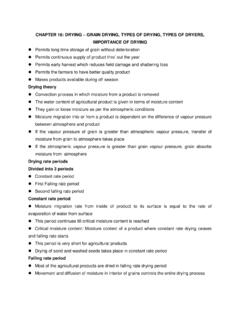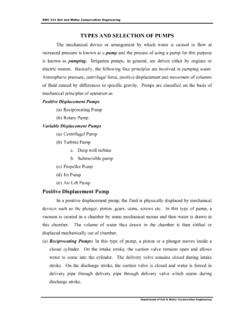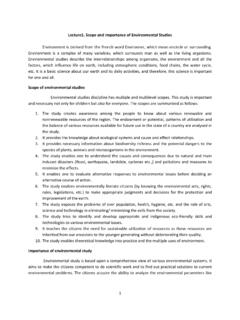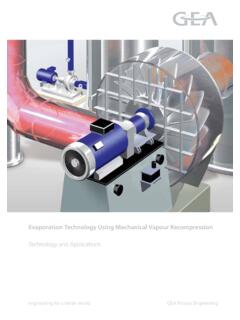Transcription of CHAPTER 21: EVAPORATION – PRINCIPLES, TYPES OF …
1 CHAPTER 21: EVAPORATION principles , TYPES OF EVAPORATORS EVAPORATION is an operation used to remove a liquid from a solution, suspension, or emulsion by boiling off some of the liquid. It is thus a thermal separation, or thermal concentration, process. We define the EVAPORATION process as one that starts with a liquid product and ends up with a more concentrated, but still liquid and still pumpable concentrate as the main product from the process. There are actually a few instances where the evaporated, volatile component is the main product, but we will not discuss that here.
2 In most cases it is essential that the product be subject to minimal thermal degradation during the EVAPORATION process, requiring that temperature and time exposure must be minimized. This and other requirements brought on by the physical characteristics of the processed product have resulted in the development of a large range of different evaporator TYPES . Additional demands for energy efficiency and minimized environmental impact have driven development toward very innovative plant configurations and equipment design. In the field of thermal separation / concentration technology, EVAPORATION plants are widely used for concentration of liquids in the form of solutions, suspensions, and emulsions.
3 The major requirement in the field of EVAPORATION technology is to maintain the quality of the liquid during EVAPORATION and to avoid damage to the product. This may require the liquid to be exposed to the lowest possible boiling temperature for the shortest period of time. This and numerous other requirements and limitations have resulted in a wide variation of designs available today. In almost all evaporators the heating medium is steam, which heats a product on the other side of a heat transfer surface. The following list contains the descriptions of the most common TYPES of evaporators.
4 1. falling film Evaporators 2. Rising film Evaporators 3. Forced Circulation Evaporators 4. Plate Evaporators 5. Thermal and Mechanical Vapor Recompression (TVR & MVR) Typical evaporator applications: Product concentration Dryer feed pre-concentration Volume reduction Water / solvent recovery Crystallization falling film Evaporators In falling film evaporators, liquid and vapors flow downwards in parallel flow. The liquid to be concentrated is preheated to boiling temperature. An even thin film enters the heating tubes via a distribution device in the head of the evaporator , flows downward at boiling temperature, and is partially evaporated.
5 This gravity-induced downward movement is increasingly augmented by the co-current vapor flow. falling film evaporators can be operated with very low temperature differences between the heating media and the boiling liquid, and they also have very short product contact times, typically just a few seconds per pass. These characteristics make the falling film evaporator particularly suitable for heat-sensitive products, and it is today the most frequently used type of evaporator . Fig. 1. falling film evaporator However, falling film evaporators must be designed very carefully for each operating condition; sufficient wetting of the heating surface by liquid is extremely important for trouble-free operation of the plant.
6 If the heating surfaces are not wetted sufficiently, dry patches and incrustations will occur; at worst, the heating tubes will be completely clogged. In critical cases extending or dividing the evaporator effects, keeping the advantages of single pass operation, can increase the wetting rate. The proper design of the liquid distribution system is critical to achieve full and even product wetting of the tubes. Because of the low liquid holding volume in this type of unit, the falling film evaporator can be started up quickly and changed to cleaning A: Product B: Vapor C: Concentrate D: Heating Steam E: Condensate 1: Head 2: Calandria 3: Calandria, Lower part 4: Mixing Channel 5: Vapor Separator mode or another product easily.
7 falling film evaporators are highly responsive to alterations of parameters such as energy supply; vacuum, feed rate, concentrations, etc. When equipped with a well-designed automatic control system they can produce a very consistent concentrated product. The fact that falling film evaporators can be operated with small temperature differences makes it possible to use them in multiple effect configurations or with mechanical vapor compression systems in modern plants with very low energy consumption. Rising film Evaporators These operate on a "thermo-siphon" principle.
8 Feed enters the bottom of the heating tubes and as it heats, steam begins to form. The ascending force of this steam produced during the boiling causes liquid and vapors to flow upwards in parallel flow. At the same time the production of vapor increases and the product is pressed as a thin film on the walls of the tubes, and the liquid rises upwards. Rising film evaporator This co-current upward movement has the beneficial effect of creating a high degree of turbulence in the liquid. This is advantageous during EVAPORATION of highly viscous products and products that have a tendency to foul the heating surfaces.
9 Usually there must be a rather high temperature difference between the heating and boiling sides of this type of evaporator . Otherwise the energy of the vapor flow is not sufficient to convey the liquid and to produce the rising film . The length of the boiling tubes will typically not exceed 23 ft. This type of evaporator is often used with product recirculation, where some of the formed concentrate is reintroduced back to the feed inlet in order to produce sufficient liquid loading inside the boiling tubes. Forced Circulation evaporator Forced circulation evaporators are used if boiling of the product on the heating surfaces is to be avoided due to the fouling characteristics of the product, or to avoid crystallization.
10 The A: Product B: Vapor C: Concentrate D: Heating Steam E: Condensate flow velocity in the tubes must be high, and high-capacity pumps are required. The circulating liquid is heated when it flows through the heat exchanger and then partially evaporated when the pressure is reduced in the separator, cooling the liquid to the boiling temperature corresponding to this pressure. Fig. 3. Forced Circulation evaporator The liquid is typically heated only a few degrees for each pass through the heat exchanger, which means the recirculation flow rate has to be high.










